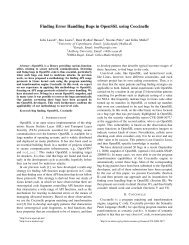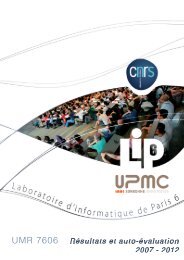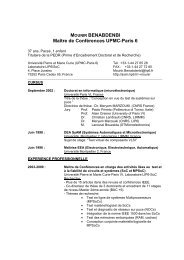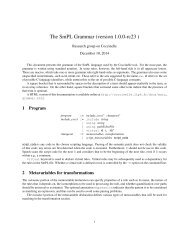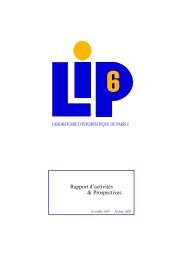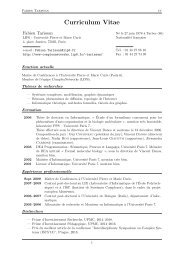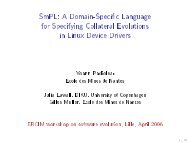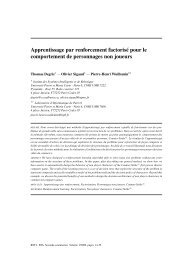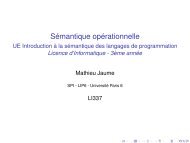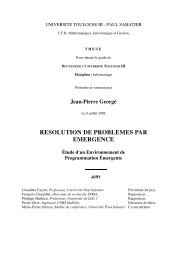Proceedings [PDF] - Measurement and Analysis of P2P Activity ...
Proceedings [PDF] - Measurement and Analysis of P2P Activity ...
Proceedings [PDF] - Measurement and Analysis of P2P Activity ...
You also want an ePaper? Increase the reach of your titles
YUMPU automatically turns print PDFs into web optimized ePapers that Google loves.
International Conference Advances in the <strong>Analysis</strong> <strong>of</strong> Online Paedophile <strong>Activity</strong> Paris, France; 2-3 June, 2009<br />
particularly active. It must also be born in mind that even if a small proportion <strong>of</strong><br />
exchanges are sexual in nature, the vast number <strong>of</strong> exchanges in general still suggests a<br />
very large number <strong>of</strong> sexually motivated <strong>P2P</strong> users. Hughes et al. do not pr<strong>of</strong>ile the<br />
pornography users in their study but they do cite the importance <strong>of</strong> group-specific norms as<br />
a basis for the notion <strong>of</strong> a tightly identified sub-community <strong>of</strong> sexually motivated users.<br />
This leads to the intriguing possibility <strong>of</strong> a more specific analysis in which more tightly<br />
defined paraphilia based sub-communities may be uncovered. The most troubling <strong>and</strong><br />
contentious <strong>of</strong> these, <strong>of</strong> course, is paedophilia.<br />
Much <strong>of</strong> the polemic against the <strong>P2P</strong> exchange <strong>of</strong> pornographic material is fuelled by the<br />
fact that such exchanges include material depicting the sexual abuse <strong>of</strong> children. The<br />
report from the General Accounting Office estimates that 42% <strong>of</strong> pornography exchanges<br />
on <strong>P2P</strong> networks involve children. Even allowing for fairly lax criteria for making such<br />
judgements, the anonymity <strong>and</strong> ease <strong>of</strong> access <strong>of</strong> <strong>P2P</strong> networks clearly facilitates the<br />
exchange <strong>of</strong> depictions <strong>of</strong> child abuse.<br />
This paper describes a methodology for pr<strong>of</strong>iling paraphilic use <strong>of</strong> <strong>P2P</strong> networks. We use a<br />
specifically psychological-psychiatric focus to the pr<strong>of</strong>iling problem. The focus here is<br />
upon deviant patterns <strong>of</strong> sexual interest rather than the legal framework that defines sexual<br />
<strong>of</strong>fending <strong>and</strong> abuse. For this reason we discriminate two paraphilic groupings associated<br />
with child molestation, these are the paedophile <strong>and</strong> the hebephile (Blanchard et al., 2008).<br />
While the paedophile manifests a sexual interest in prepubescent children, the hebephile is<br />
sexually interested in pubescent or recently post-pubescent children. Legally, the<br />
difference is largely unclear but psychologically the arousal pattern <strong>of</strong> the hebephile to<br />
secondary sexual characteristics is more in keeping with those <strong>of</strong> a normal adult. This does<br />
not suggest that hebephilia is less socially problematic than paedophilia but merely that<br />
there may be different underlying pathologies at work, so grouping them together may<br />
ultimately prove unhelpful.<br />
Aims<br />
The aims <strong>of</strong> this paper are to report on developments following an earlier study in which<br />
we explored the associations between sexual interest themes using exploratory <strong>and</strong><br />
heuristic multidimensional scaling methods (Quayle, Hammond <strong>and</strong> Wynne, 2007). The<br />
aim <strong>of</strong> this report is to examine taxonomies <strong>of</strong> paraphilic sexual interest informed by the<br />
search terms individuals employ in their <strong>P2P</strong> interactions <strong>and</strong> it takes a more model-based<br />
approach to the examination <strong>of</strong> sexual interest themes.<br />
The Data<br />
Method<br />
The present report is based upon two data sets made available through the MAPAP project<br />
team. The first <strong>of</strong> these data sets comprises a list <strong>of</strong> the 119,869 most commonly used<br />
terms in <strong>P2P</strong> submissions over the period <strong>of</strong> one week. This data set we will call the<br />
Search Terms List (STL). The second data set comprises all eDonkey transactions over this<br />
66


![Proceedings [PDF] - Measurement and Analysis of P2P Activity ...](https://img.yumpu.com/32964521/66/500x640/proceedings-pdf-measurement-and-analysis-of-p2p-activity-.jpg)

